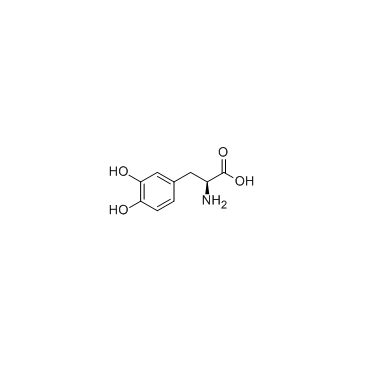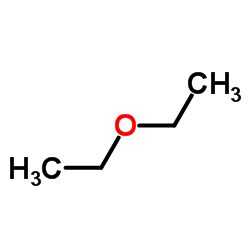L-3,4-Dihydroxyphenylalanine Methyl ester hydrochloride

L-3,4-Dihydroxyphenylalanine Methyl ester hydrochloride structure
|
Common Name | L-3,4-Dihydroxyphenylalanine Methyl ester hydrochloride | ||
|---|---|---|---|---|
| CAS Number | 1421-65-4 | Molecular Weight | 247.676 | |
| Density | 1.322g/cm3 | Boiling Point | 384.4ºC at 760mmHg | |
| Molecular Formula | C10H14ClNO4 | Melting Point | N/A | |
| MSDS | USA | Flash Point | 186.3ºC | |
Use of L-3,4-Dihydroxyphenylalanine Methyl ester hydrochlorideMelevodopa hydrochloride is a biochemical. |
| Name | L-DOPA Methyl Ester Hydrochloride |
|---|---|
| Synonym | More Synonyms |
| Density | 1.322g/cm3 |
|---|---|
| Boiling Point | 384.4ºC at 760mmHg |
| Molecular Formula | C10H14ClNO4 |
| Molecular Weight | 247.676 |
| Flash Point | 186.3ºC |
| Exact Mass | 247.061142 |
| PSA | 92.78000 |
| LogP | 1.64290 |
| Vapour Pressure | 1.86E-06mmHg at 25°C |
| Storage condition | -20°C |
| Hazard Codes | Xi |
|---|---|
| RIDADR | NONH for all modes of transport |
| HS Code | 2923900090 |
|
~99% 
L-3,4-Dihydroxy... CAS#:1421-65-4 |
| Literature: Journal of Medicinal Chemistry, , vol. 44, # 21 p. 3488 - 3503 |
|
~% 
L-3,4-Dihydroxy... CAS#:1421-65-4 |
| Literature: US5952328 A1, ; US 5952328 A |
|
~% 
L-3,4-Dihydroxy... CAS#:1421-65-4 |
| Literature: US5387610 A1, ; |
| Precursor 3 | |
|---|---|
| DownStream 0 | |
| HS Code | 2923900090 |
|---|---|
| Summary | 2923900090 other quaternary ammonium salts and hydroxides。Supervision conditions:None。VAT:17.0%。Tax rebate rate:9.0%。MFN tariff:6.5%。General tariff:30.0% |
|
Striatal astrocytes act as a reservoir for L-DOPA.
PLoS ONE 9(9) , e106362, (2014) L-DOPA is therapeutically efficacious in patients with Parkinson's disease (PD), although dopamine (DA) neurons are severely degenerated. Since cortical astrocytes express neutral amino acid transport... |
|
|
L-DOPA-induced dyskinesia in a rat model of Parkinson's disease is associated with the fluctuational release of norepinephrine in the sensorimotor striatum.
J. Neurosci. Res. 92(12) , 1733-45, (2014) L-3,4-dihydroxyphenylalanine (L-DOPA)-induced dyskinesia (LID) is the most common complication of standard L-DOPA therapy for Parkinson's disease experienced by most parkinsonian patients. LID is asso... |
|
|
Genome-wide microarray analysis identifies a potential role for striatal retrograde endocannabinoid signaling in the pathogenesis of experimental L-DOPA-induced dyskinesia.
Synapse 68(8) , 332-43, (2014) l-3,4-Dihydroxyphenylalanine (L-DOPA) is the most widely used drug for the treatment of Parkinson's disease. Unfortunately, chronic administration of this dopamine precursor causes L-DOPA-induced dysk... |
| L-Tyrosine, 3-hydroxy-, methyl ester, hydrochloride |
| MFCD00038958 |
| L-Tyrosine, 3-hydroxy-, methyl ester, hydrochloride (1:1) |
| L-3,4-Dihydroxyphenylalanine methyl ester hydrochloride |
| methyl (2S)-2-amino-3-(3,4-dihydroxyphenyl)propanoate,hydrochloride |
| Methyl 3-hydroxy-L-tyrosinate hydrochloride (1:1) |
| (S)-Methyl 2-amino-3-(3,4-dihydroxyphenyl)propanoate hydrochloride |
| Methyl L-DOPA hydrochloride |
| methyldopa hydrochloride |


